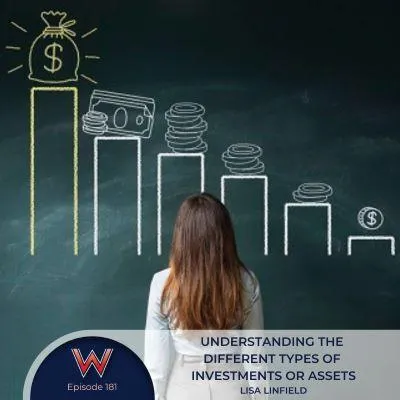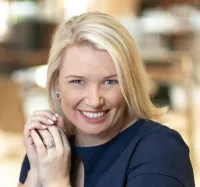Browse for the latest episode of...
working women's wealth

181 Understanding the different types of investments or assets
Ready to invest, but confused by industry jargon? Translated into HumanSpeak you will be able to understand the different types of investments or assets.
This week I’m going to teach you the type of assets you can invest in when you invest in funds, as well as give you some generalised guidelines for the average person as to how much money you should have in each type of investment.
As always, I will say that I don’t know your personal circumstances, so I can’t advise you specifically, but you will truly be amazed at how, with repeated listening, you will be able to have a better discussion with your financial adviser, partner and friends about money.
Don’t take what they say at face value without asking the questions you need to!.
Show notes:
[02.31] So what is an asset?
[04.44] What are investment assets?
[06.22] Risk vs Return
[09.09] Low Risk Assets or Income Assets
[14.19] Medium Risk Investments
[14.54] High risk investments
[15.11] The huge importance of “asset allocation”
[16.44] So how much money should I have in each type of investment?
[18.17] Putting it together – done for you
Quotes
“You have a higher chance of making more money if you take more risk, but that chance of losing money also gets higher with each element of risk.” - Lisa Linfield
“Your money needs to grow, or have a return on your investment, that is at LEAST meeting inflation each year.” - Lisa Linfield
“One of the biggest destroyers of money is the human being themselves.” - Lisa Linfield
Related posts and episodes
How much is enough?
Investing Tax free!
Optimising tax on your investments
The decision tree you need to choose your investment
The four foundations of investing
Four things you need to know about your home(financially)
Why you should invest offshore
Why your home is NOT an investment
Subscribe to our podcast on iTunes or Spotify
Please do Subscribe to our Podcast on iTunes or Spotify and leave a review. This helps the podcast to rank higher and therefore makes it more visible to others browsing podcasts in the hope they too may benefit from our content.
Get my book - Deep Grooves: Overcoming Patterns that Keep you Stuck
You can get the first two chapters of my book FREE here
If you want a paperback copy and you’re in South Africa, visit my site LisaLinfield.com
If you want a Kindle copy or a paperback anywhere in the world, visit Amazon
TRANSCRIPT
Hello everyone and welcome to today’s episode of Working Women’s Wealth. I’m Lisa Linfield and I’m building a community of Women who are committed to the journey of living Financially Free lives – whether you’re just beginning, or nearly there, we support each other through our lessons learnt, good and bad, so ALL may benefit.
Over the last few episodes we’ve looked at how you invest.
In Episode 174, we looked at how much money you need to stop working – and I gave you a simple formula to help you work that out.
In episode 173, we discussed the first place you should put your money when you start investing - the Tax Free investment options in your country. That money is long term money, that you should try “forget about”.
In last weeks episode, we looked at the four foundations to investing that you need to take into consideration for EACH investment.
Now you’re ready to invest…. So in Episode 179 we looked what you should invest in and why I recommend investing in funds and not single shares.
But the question always raises its head of ‘which fund’?
Now, as always, I will say that I don’t know your personal circumstances, so I can’t advise you specifically. But, as always, I want to teach you how to understand the landscape of investing so you can make the best choices available.
So today I’m going to teach you the type of assets you can invest in when you invest in those funds, and next week we will pull it all together in ‘The Decision Tree of Investing’.
Let’s do it!
There are different types of investments you can put your money into, or in the investment industry, they’re known as assets.
So what is an asset?
According to Investopedia,
An asset is a resource with economic value that an individual, corporation, or country owns or controls with the expectation that it will provide a future benefit
So let’s translate that:
● A resource is something that can be used to help you (Cambridge American Dictionary)
● Economic Value is the value a person places on that useful good – measured in money terms
● That you own
● With the expectation that it will provide you benefit in the future.
So, in HumanSpeak we’d say that
An asset is something of value that you own that can help you provide a benefit in the future.
Now for completeness sake, that asset can be physical or not physical. For example, if you knew the recipe of Coke in your head - that could provide you a benefit in the future. The recipe is not something you can touch, it’s something you know. If you owned the Coke Brand, that also would provide you benefit in the future. A brand is not something you can touch, it’s something you feel, trust, and is known by many people to represent a product or service.
So let’s get back to assets that you invest in.
An asset you invest in therefore is something that will provide you future benefit. Either because you can sell it for a higher price, or because each year it will give you some form of income that will grow over time. And the aim of investment assets is that they will grow over time – either the value or price of the asset, or the value of the annual income streams … but hopefully both.
What are investment assets?
Well, because an investment is ANYTHING that can provide a future, an investment asset can be anything that two people agree have value. How much value – well that depends on what someone is prepared to pay… or demand. When lots of people want your asset, the price will go up. When no one wants it, it doesn’t matter how much you think it’s worth, no one will pay for it.
Take art for example. There are pieces of art that some people are prepared to pay a million dollars for that you would have to pay me to have in my house. But if there are 40 other people that want desperately to buy that painting, they can push the value sky high. The price you get for your asset has nothing to do with what you paid for it, or the time you’ve had it. It totally depends on what others are prepared to pay for it.
So whilst there are many, what are known as ‘Alternative Investments’ such as art, today we are focusing on investments that you can buy on the open market, that are traded frequently.
Risk vs Return
And as we mentioned last week, there are four foundations that underpin all investing:
There is a trade off between the risk you are willing to take, and the return on the investment you will make (or money you will make). You have a higher chance of making more money if you take more risk – but also a higher chance of losing your money.
That risk is modified by TIME. For higher risk assets, the longer you have, the more certainty you have of making that higher return. For lower risk assets that earn less than inflation, like a savings account, a long period of time gives you more certainty of losing the buying power of your money. Why?
That brings us to the third foundation – inflation. Your money needs to grow or have a return on your investment that at LEAST meets inflation. This means that the money you invest today needs to buy you at least the same amount of stuff in 10 years time as it buys you today. That’s why you should always think of the amount your money grows each year in terms of inflation. So if it grows 8% and inflation is 5%... then it’s growing at Inflation +3%
And the last foundation of investing is to understand you. Your Money Being, or the way you think, feel and behave towards money; your current financial position; and your personal Investment Risk Profile.
So when we look at assets, we look at the Risk that asset has against the Return on the investment you will make – or the money you will make – over a certain period of time. And we will speak of that return in terms of inflation plus.
Low Risk Assets or Income Assets
Low risk assets are often referred to as income assets, as traditionally, people have put their money into these investments or assets when they want an income in retirement.
The least risk is a bank savings account… and so it gives you the lowest return or makes you the least money for the investment you make. You put your money in the saving’s account and you earn interest on it. Usually, you will earn less interest in a bank account than inflation.
When to use this? You should only use savings accounts for short period of time. But in general, they are safe and you are guaranteed to get your money back… and a weeny bit more.
The next step upwards are money market accounts. You can usually also get a money market account from your bank, and usually you need to either hold it for a longer period of time, or invest a bigger amount of money. They pay you interest, and usually more interest than a bank account. Sometimes, you can get the same amount of interest or slightly more than inflation. This means that you’d put money in that account that is for a period of a year, maybe two,
When to use this? Usually this is used for things like your emergency account – where you want to make sure that as your expenses rise with inflation, so your emergency account will grow with inflation – so you always keep 6 months expenses there (and it doesn’t become 5 months over time!!!).
Next up are what is known as Bonds. Now a Bond is when you lend money to someone and they pay you back at a set interest rate. Sometimes a home loan is referred to as a bond. But in this case, the investment bonds we’re talking about are issued by countries or big, safe companies such as Coca Cola or Microsoft. The safer the country or company, the less interest you will earn, the more risky the country or company, the more interest you will earn. There’s also a factor of TIME – if you lend for 2 years you will usually get less money than if you lend for 10 years.
So a US bond is you lending money to the US government. A 2 year bond will give you 0.16% each year return, and a 10 year bond will give you 1.56% each year. In the US, with inflation at 1.25% currently, your money will go backwards over time… but it’s a very safe investment.
A South African Bond is you lending to the SA government. A 2 year bond will give you 4.6% and a 10 year bond will give you 9.16%. With inflation at 3.3%, both the 2 year and the 10 year bond will give you an investment return above inflation – with the 10 year bond giving you almost a 6% return above inflation – unheard of for a relatively safer investment than shares. But, there is more risk that the South African government won’t pay you back than the US government.
When to use this? When you have 2 or more years to invest and want a lower risk and near guaranteed return
The last step in the low risk assets category is income funds.
As we mentioned in Episode 179, a fund is managed by a fund manager (active). Income funds are a mix of cash, money market and bonds, and the fund manager chooses a mix that he thinks will bring him the highest return for the risk he is mandated to take. If it’s a high risk income fund, he may invest in company bonds in risky countries… and a low risk fund may be only US products in US dollars.
When to use this? I use income funds for 1-3 year investment period when you can’t afford to lose the money (like saving money for the deposit on a house), or to reduce the risk in an investment portfolio when the person’s personal risk profile is cautious or average. I also use it for the first two year’s funds when people are drawing money down in retirement.
In general, income assets or low risk funds are something I ALWAYS invest in active management and never invest in passives here.
Medium Risk Investments
Medium risk investments are property and shares.
Now even within property and shares, there’s a very wide range of risk in there. Some people tend to look at size – so they say that the big companies have less risk than the small companies. Some people look at industry – so the fact that people will always buy toothpaste, but maybe not apple devices. And some people look at price – so they don’t mind what size or industry, they’re looking at shares where the price is low for the value you get.
High risk investments
High risk investments are things like private businesses, futures contracts, bitcoin or other ‘flavour of the month’ investing. Unless you know your stuff, don’t invest in these – or limit them to 1-2% of your wealth.
The huge importance of “asset allocation”
There is a huge amount of research that shows that one of the most important factors in how much money you make of your investments over the long terms depends on what’s called your Asset Allocation. This is the percent or proportion of your total investment portfolio that is in income assets, vs property vs shares vs other investments.
NOT which single share you bought.
And the reason for this is that in any year, the best performing asset changes. When the share market crashes, the best performing asset will be income funds. Why? Because the shares will lose money, and the money market accounts will earn their fixed, positive interest rates each month.
But, when the shares market is growing, it will earn more return than the income funds.
So it’s very important that you have a little of everything in your investments so that over time, it will perform well… and when one’s not doing so well, the other will step up.
So how much money should I have in each type of investment?
It comes down to the time horizon of the investment (or how long you will keep the money there), and the risk you’re prepared to take.
So let me give you some generalised guidelines for the average person
● Less than a year, Money Market
● 1-3 years for a cautious person, income funds
● 3-5 years – low equity fund – with 30-40% shares and property, and the rest in the low risk income funds
● 4-7 years – high equity fund with 60-75% shares and property and the rest in income funds
● 7 years plus – flexible funds (which can invest in anything that they believe can generate a high return) or share portfolios.
Now these are the theories the text books will tell you.
One of the biggest destroyer of money is the human being. So even if your money is for longer than 7 years, if you’re not able to leave it alone, and you get too jumpy if the value bounces around each day, then you will need to invest in lower risk options than the time frame recommends.
Putting it together – done for you
The good news is that you don’t have to worry about putting it all together yourself!
You can choose a fund that does it all for you. You can get ‘off the shelf’ funds with the right amount of income or risky assets for your time horizon. And most investment houses or passive tracker companies will offer an income fund, a ‘cautious’ or low risk fund, a ‘balanced’ or higher risk fund, and a flexible or share fund.
So all you need to do is choose which one works for you.
Now I know that may have felt like a little brain gym… but trust me, next week when we put it all together, you will be able to then choose exactly what you should invest in.
Stick with this learning friends – you will truly be amazed at how, with repeated listening, you will be able to have a better discussion with your financial adviser, partner and friends about money – and don’t take what they say at face value without asking the questions you need to.

Explore
On Social
YourBrand.com - All Rights Reserved - Terms & Conditions

